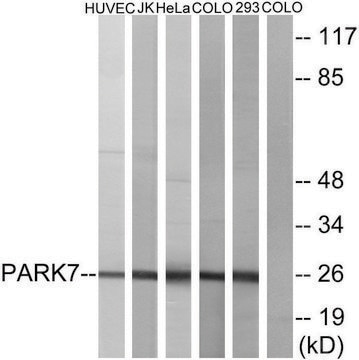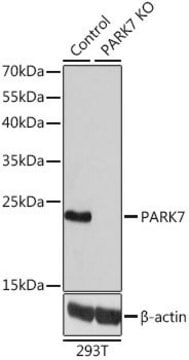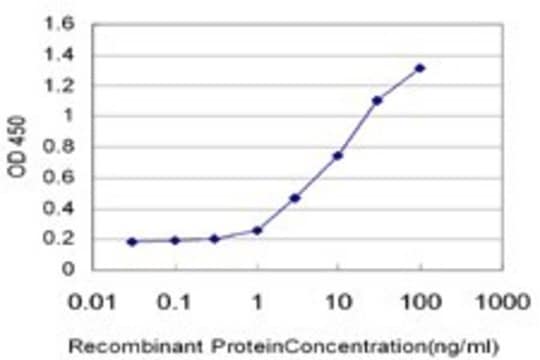MABN1773
Anti-oxDJ-1 Antibody (Cys106), clone M149
clone M149, from mouse
Synonim(y):
Protein DJ-1, Oncogene DJ1, Parkinson disease protein 7, oxDJ-1 (Cys106)
About This Item
Polecane produkty
pochodzenie biologiczne
mouse
Poziom jakości
forma przeciwciała
purified immunoglobulin
rodzaj przeciwciała
primary antibodies
klon
M149, monoclonal
reaktywność gatunkowa
mouse, human
metody
immunohistochemistry: suitable
western blot: suitable
izotyp
IgG2aκ
numer dostępu NCBI
numer dostępu UniProt
Warunki transportu
wet ice
docelowa modyfikacja potranslacyjna
unmodified
informacje o genach
human ... PARK7(11315)
Opis ogólny
Specyficzność
Immunogen
Zastosowanie
Western Blotting Analysis: A reporesentative lot detected basal DJ-1 oxidation (oxDJ-1) in human neuroblastoma SH-SY5Y cells and murine fibroblasts from wild-type, but not DJ-1 knockout, mice, as well as enhanced oxDJ-1 in H2O2-treated SH-SY5Y cells (Saito, Y., et al. (2014). J Neuropathol Exp Neurol. 73(7):714-728.).
Neuroscience
Developmental Signaling
Jakość
Western Blotting Analysis: 0.1 µg/mL of this antibody detected enhanced DJ-1 oxidation in 10 µg cell lysate from H2O2-treated human neuroblastoma SH-SY5Y cells.
Opis wartości docelowych
Postać fizyczna
Przechowywanie i stabilność
Inne uwagi
Oświadczenie o zrzeczeniu się odpowiedzialności
Nie możesz znaleźć właściwego produktu?
Wypróbuj nasz Narzędzie selektora produktów.
Kod klasy składowania
12 - Non Combustible Liquids
Klasa zagrożenia wodnego (WGK)
WGK 1
Temperatura zapłonu (°F)
Not applicable
Temperatura zapłonu (°C)
Not applicable
Certyfikaty analizy (CoA)
Poszukaj Certyfikaty analizy (CoA), wpisując numer partii/serii produktów. Numery serii i partii można znaleźć na etykiecie produktu po słowach „seria” lub „partia”.
Masz już ten produkt?
Dokumenty związane z niedawno zakupionymi produktami zostały zamieszczone w Bibliotece dokumentów.
Nasz zespół naukowców ma doświadczenie we wszystkich obszarach badań, w tym w naukach przyrodniczych, materiałoznawstwie, syntezie chemicznej, chromatografii, analityce i wielu innych dziedzinach.
Skontaktuj się z zespołem ds. pomocy technicznej







